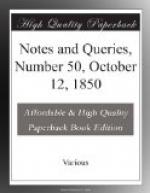Bookbinding.—While the mischief of mildew on the inside of books has engaged some correspondents to seek for a remedy (Vol. ii., 103. 173.), a word may be put in on behalf of the outside, the binding. The present material used in binding is so soft, flabby, and unsound, that it will not endure a week’s service. I have seen a bound volume lately, with a name of repute attached to it; and certainly the workmanship is creditable enough, but the leather is just as miserable as any from the commonest workshop. The volume cannot have been bound many months, and yet even now, though in good hands, it is beginning to rub smooth, and to look, what best expresses it emphatically, shabby, contrasting most grievously with the leather of another volume, just then in use, bound some fifty or seventy years ago, and as sound and firm as a drum’s head—common binding too, be it observed—as the modern cover is flabby and washy. Pray, sir, raise a voice against this wretched material, for that is the thing in fault, not the workmanship; and if more must be paid for undoctored outsides, let it be so.
NOVUS.
Scott’s Waverley.—Some years ago, a gentleman of my acquaintance, now residing in foreign parts, told me the following story:—
“Once upon a time,” the great unknown being engaged in a shooting-match near his dwelling, it came to pass that all the gun-wadding was spent, so that he was obliged to fetch paper instead. After Sir Walter had come back, his fellow-shooter chanced to look at the succedaneum, and was not a little astonished to see it formed part of a tale written by his entertainer’s hand. By his friend’s urgent inquiries, the Scotch romancer was compelled to acknowledge himself the author, and to save the well nigh destroyed manuscript of Waverley.
I do not know whether Sir Walter Scott was induced by this incident to publish the first of his tales or not; perhaps it occurred after several of his novels had been printed. Now, if any body acquainted with the anecdote I relate should perchance hit upon my endeavour to give it an English garb, he would do me a pleasure by noting down the particulars I might have omitted or mis-stated. I never saw the fact recorded.
JANUS DOUSA.
Satyavrata.—Mr. Kemble, Salomon and Saturn, p. 129., does not seem to be aware that the Satyavrata in question was one of the forgeries imposed on, and afterwards detected, by Wilford.
F.Q.
* * * * *
QUERIES.
BLACK ROOD OF SCOTLAND.
Can any of your correspondents give me any information on the following points connected with “the Black Rood of Scotland?”
1. What was the history of this cross before it was taken into Scotland by St. Margaret, on the occasion of her marriage with Malcolm, king of Scotland? Did she get it in England or in Germany?




